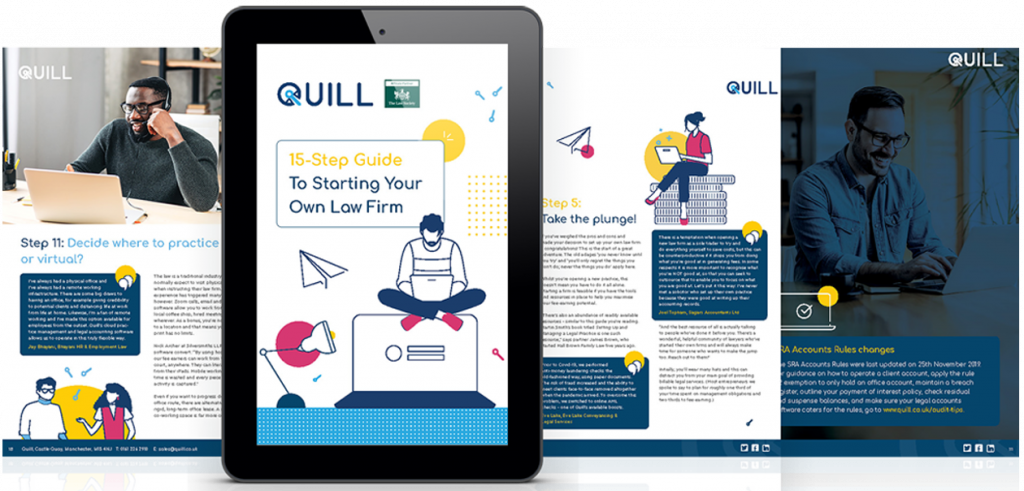
Guide to Starting Your Own Law Firm: Steps 1-3
24/11/20Steps 1-3 of how to start your own law firm in the UK, covering how to open a bank account, apply for PI insurance and create a comprehensive business plan.
Starting your own law firm is an appealing and rewarding way to make a living – and life – but it can seem like a pipe dream.
But if you have the will and desire to take the plunge, you’ll be in good company. According to the SRA, one in six of all law firms are sole practitioners and on average, two new firms open every working day.
With the pandemic leading to job redundancies and many solicitors re-evaluating their priorities and life goals, this number is expected to climb in 2020 and beyond. Plus, with remote agile working now commonplace, the start-up process is not only easier, but cheaper too.
So, if you’re one of these budding legal entrepreneurs, you’re in the right place. This guide is the first step in putting your dreams into action. It will help you understand the practicalities of setting up a law firm and answer:
1. Where do you even start?
2. What do you need to do?
3. Legal, accounting and finances – what’s best?
4. Who can you ask for help?
5. What systems do you need in place?
The first in our series will cover steps 1-3, which we consider the three most crucial steps to starting a law firm. These steps are intertwined – you can’t open a bank account or apply for insurance without a business plan, but you may not want to create a comprehensive business plan until you’re sure you can secure insurance, so please bear this in mind as we talk you through the steps.
WATCH WEBINAR:
Step 1: Open a business account with a bank
“Until this year, opening a business account certainly wouldn’t have been step one,” said David Gilmore from DG Legal in the webinar. “But because of the pandemic, I’m afraid it’s incredibly difficult to open an account.”
Normally, this would be quite a straightforward process but many banks have stopped accepting new applications for business bank accounts since the coronavirus pandemic surged in the UK.
This is predominantly due to increased demand for government-backed emergency loans like Bounce Back Loans and the Coronavirus Business Interruption Loans. Operationally, banks are inundated with these requests, have a huge backlog and are focusing on their existing customers’ most pressing needs. Many are scaling back or stopping new business account requests altogether.
“Finding a bank that will open a business account is the number one issue we’re seeing new businesses facing at the moment. Just this week, I was told by Metrobank that they’re not opening new accounts until next year and Barclays currently have a turnaround of 12-16 weeks.”
– David Gilmore
Your best chance is to turn to your existing bank to open a business account as they’re more likely to support you as an existing customer.”
DOWNLOAD eBOOK
Step 2: Purchase Professional Indemnity Insurance
“Obtaining the promise of Professional Indemnity cover is the next important step—everything else is a waste of time if you can’t get insurance,” explains David Gilmore. “This is the first year that we’re also seeing some clients struggle to obtain PI cover. This is because many insurances have met their targets, plus the insurance market has hardened and some providers have dropped out of the market altogether.”
A certificate of insurance is a must before you start to practise and details of your PII cover need to be included in your FA1 form. Your PII must be secured from a qualifying insurer who abides by the regulator’s strict terms, such as minimum cover levels.
In order to request insurance quotes, you’ll be asked to attach supporting documentation including a business plan along with financial projections (incomings and outgoings) and CVs of senior personnel.
“Unlike the advice you hear about care insurance, don’t be tempted to shop around too much for PI insurance,” says David Gilmore. “If you approach a number of brokers, be aware that these brokers will often send your proposal to the same firms. The underwriters at the insurance companies could get fed up of seeing the same proposal form and sometimes refuse to quote. The best plan is to act early and ethically and in your best interests. Don’t leave things too late and risk not having enough time to obtain a good quote.”
Another tip: A good broker can help you during this stage, but stick to one or a maximum of two and be wary that there are some unscrupulous ones out there. This is when you want to ask your community for recommendations rather than just blindly picking one.
PII no longer follows automatically upon authorisation; instead, a quote takes about a fortnight to receive. Expect to pay, on average, 5% of your turnover on PII. These recurring costs should be built into your cash flow forecasts. Along with Professional Indemnity, you’ll also need workers’ compensation, property and casualty insurance.
It’s always best to have your eyes wide open so you can understand clearly just how profitable your endeavour will be when all financials are taken into account.
Step 3: Formulate your business plan
If you have no plan, you have no business. And a law firm is first and foremost a small business. The phrase ‘cash is king’ applies here. But were you taught much about balance sheets, equipment amortisation, cost analysis and the like in law school? Highly doubtful.
But it’s not as scary as it seems. You don’t need a fancy business degree in your back pocket — you can hire outside accountants and tax specialists when the time comes (and if your budget allows, of course).
“Business plan can feel quite daunting but I actually find it quite exciting,” said Joel Topham from Sagars Accountants Ltd during the webinar. “Use it to set up what you want to do and where you want to be for the next one, five, and 10 years. Banks and insurance consider this a really key component of setting up your law firm and will want to see that you thought about it deliberately and you have some sensible assumptions behind it.”
Meanwhile, it’s relatively simple to draft the bones of your plan by covering the topics outlined below:
- Company overview: How your business has come about, its specialisms, make up, funding and pricing structure.
- Services and pricing: Which areas of law will form your service offerings (full service or niche specialisms) and what’s your costing model (fixed fee, time-based billing or both)?
- Market and customers: Market size, ideal client persona and desired market share.
- Marketing and business development strategy: Draw data from your strengths, weaknesses, opportunities and threats (SWOT) as well as political, economic, socio-cultural, and technological factors (PEST), plus competitor analysis. This will help you strategise how you’ll win and retain clients as well as overcome unavoidable challenges outside of your control.
- Budget: A detailed and accurate budget is a must if you want to build a thriving, sustainable business; it’s an overview of your finances which outlines key information on both your current and future income and expenses.
- Sales plan: You’ll need to produce a cash flow forecast covering the first two years because (a) it’s really hard to get beyond two years (especially in the current environment) and (b) it is what PI insurers expect.
- Risk management and contingency planning: Share how you will ensure business continuity and mitigate risks to your new business.
- People: Who will you hire to support your business and what are you planning to outsource?
- Action plan: This summarises your objectives and explains the actions necessary, who will be involved, the cost and the benefit and a timescale.
- Executive summary: This actually comes first but is best written last; it combines all of the above content in concise summary format.
“It’s a common mistake to start offering legal services in several areas of law unless you have dozens of people at the outset (and most won’t). Professional Indemnity insurers may refuse to provide a quote if they think you are spreading yourself too thinly. It’s better to start with a small number of areas of law and later diversify (if appropriate) once you’re well-established,” explains David Gilmore, DG Legal.
Another tip from Joel: Get help where you don’t have the experience. No one expects to have a handle every bit of HR and marketing. Go and find experts who know those areas better than you do and glean from them what you need. This is so you can focus on what you are good at – legal services.
This is the time to sit back and think through your ultimate career goals and build your business strategy. Remember that this plan is an organic, living document that will serve as your guiding light as your business grows. It’s not just about the numbers. It’s about your goals, principles, values as a law firm. How do you want to practice? Who do you want to help?
DOWNLOAD E-BOOK
More from our blog

24th November
Guide to Starting Your Own Law Firm: Step 4
Step 4 in starting your own law firm: how to build risk management and compliance into your business plan.

24th November
Guide to Starting Your Own Law Firm: Steps 5-8
Steps 5-8 on how to start your own law firm: why take the plunge, formally applying, choosing your business structure and managing client accounts.

24th November
Guide to Starting Your Own Law Firm: Steps 9-10
Steps 9 to 10 to starting your own law firm: how to create a realistic cashflow forecast and understand your accounting responsibilities.



